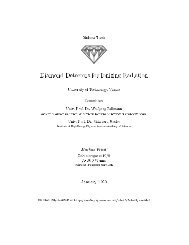Create successful ePaper yourself
Turn your PDF publications into a flip-book with our unique Google optimized e-Paper software.
7 Conclusion and OutlookAn intergrated testing facility for the Global Trigger of the CMS experiment waspresented. After establishing the context of the work in the first chapters, the precedingtwo chapters describe an implemented testing solution for the CMS Global Trigger andillustrate its application in real-world scenarios. The underlying software has beendeployed at CERN and integrated into the experiment’s operating procedures.While the accessibility of testing has been significantly improved, the developmenthas also shown that there is significant opportunity to further improve upon this status.At the time of this writing, the generation of the pattern files described in Sec. 5.2.1for a specific configuration of the system remains an expert task and needs to be doneoutside the application. Formalizing the necessary knowledge of the connections betweenthe hardware configuration specified in the online software and the associatedconfiguration for the pattern generation job in the offline software framework so thattests can be performed for arbitrary hardware configurations without expert involvementis the obvious next step. A prerequisite for this step is the consistent availabilityof this configuration information from a central database, which has only recently beenachieved.Additionally, efforts are underway to create a general framework for interconnectiontests between the different trigger subsystems. Integrating this with the currentsolution would expand the test coverage significantly by including cabling and synchronizationissues.Another interesting direction for future work is suggested by the divergent needs ofexperiment operation and hardware development - while the test procedures used toverify correct operation of the experiment must be straightforward and leave little roomfor user error, tests performed during development require the flexibility to overridesafeguards and change configuration parameters quickly and easily. In the existingsolution, priority was given to the former considerations, so that the user interfacehides much of the flexibility inherent in the underlying implementation. Developingthe current solution into a flexible tool for developers while maintaining the simplerinterface for operational tests is an interesting challenge.78












